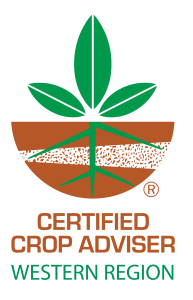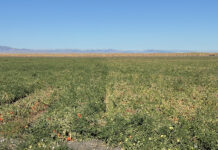
There is no doubt that almond producers have had to navigate numerous challenges over the past several years. Drought conditions, declining nut prices and regional frost events have forced growers to implement a renewed focus on input management as it relates to agronomic efficiency. Agronomic efficiency can be improved through the implementation of the 4R’s of Nutrient Stewardship, which include Right Source, Right Rate, Right Time and Right Place. Improved grower understanding of various nutrient cycles and soil nutrient loss mechanisms are allowing growers to incorporate a sophisticated layer of nutrient management that has evolved over recent years. By understanding and leveraging both the nitrogen cycle and the 4R’s, almond producers can make informed fertility decisions that maximize nitrogen use efficiency (NUE), allowing them to successfully navigate both economic and environmental headwinds.
Factors Impacting the Nitrogen Cycle
Nitrogen management is important, not only due to product cost but also because of the many loss mechanisms associated with less-than-ideal soil conditions. Almonds require a large amount of annual nitrogen to produce a commercial yield. CDFA suggests that on average, 68 lbs N are removed per 1,000 pounds of kernels with another 30+ lbs needed to maintain adequate growth (depending on tree age.) Almonds rely on large amounts of N to build both amino acids and proteins as well as for the formation of chlorophyll. To adequately supply the appropriate amount of N in an efficient manner, growers will need to understand how environmental factors impact the nitrogen cycle (Figure 1) and ensure that applications are available during periods of peak uptake and demand.

Almond trees are quite good at remobilizing N resources from perennial plant parts to annual tissues during the bloom period through fruit set. Figure 2 depicts this remobilization concept with total N remaining constant through March 12, accumulating in annual tissues while decreasing in perennial tissues. The graphic suggests that there is little uptake from applied N during this period but does not necessarily mean growers should avoid applications at this timing. Depending on soil and other environmental conditions, application timing can vary greatly during this period.
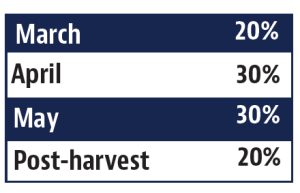
Proper application timing not only requires understanding crop uptake demand, but also how soil conditions impact nutrient form. Because common N fertilizers used by almond producers contain different combinations of urea, ammonium and/or nitrate, different considerations related to application timing are needed. The majority of almond N uptake is in the nitrate form. This requires N applied in either the ammonium or urea form to largely be converted to nitrate, making it more available for uptake. The conversion reactions such as nitrification (conversion of ammonium to nitrate) are governed by soil moisture and soil temperature. Growers should also consider rain forecasts when making early N applications because spring rain events can possibly leach nitrate out of the rootzone, resulting in not only an environmental impact but an economic impact as well.
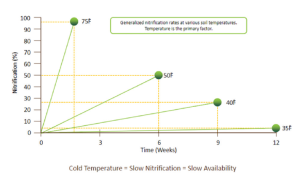
Figure 3 illustrates the relationship between nitrification rates and soil temperature. The speed at which ammonium is converted to nitrate can be dramatically different depending on soil temperature. Figure 4 is a graph generated from Wilbur Ellis’ Probe Schedule depicting soil temperatures of a mid-textured loam soil at different depths from mid-February through mid-March. Shallow soil temperatures during this period were approaching and at times exceeding 60 degrees F. When we use this information with the nitrification table, we see that it can take up to three weeks for 50% of our applied ammonium to be converted to nitrate. Heavier, cooler soils experience much slower nitrification than coarser textured soils, meaning growers should take their soil conditions, weather forecasts and N source into consideration when timing applications.
Reconciling Data into Nitrogen Application Decisions
A general rule of thumb for managing N throughout the almond growing season involves allocating large portions of the N budget to applications during four major timings. Table 1 outlines seasonal nitrogen allocations, which can be a valuable guide to timing applications but lack some of the nuance needed to understand the right rate as well as the right source to consider.
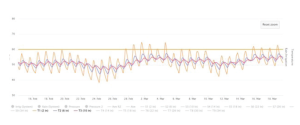
Many growers and consultants sample almond leaves throughout various time periods of the season to understand the status of various nutrients including N. It is not uncommon for leaf tissue samples to be evaluated for N status monthly starting in April through mid-July. July leaf tissue samples can be an excellent tool for growers to adjust or implement postharvest fertility applications to address any nutrient shortages prior to the remobilization of these nutrient resources to storage organs. If leaf N levels during the mid-July period are inadequate, then almond trees may not be able store enough N for next year’s bloom period. This means growers and consultants alike should consider 2022’s July tissue levels as an important data point when developing the spring fertility plan for 2023.
Another important consideration when developing the spring fertility plan is the overall yield of the previous year’s crop. When I discuss postharvest fertility with growers, I describe it as the final opportunity of the season to reconcile fertility inputs with crop exports. For most of the season, growers making most fertility decisions are guided via certain assumptions about crop load. Growers can make a pretty good assessment of crop load by late spring and into early summer, adjust their fertility accordingly and then monitor via leaf tissue analysis and/or field observations throughout the remainder of the season. Once crop starts to get harvested and loads are delivered to the processor, a clearer picture of final yield develops. If the postharvest fertility program was shorted/omitted or if yield was dramatically reduced via frost or some other phenomenon, spring fertility may need to be adjusted accordingly. Growers in the Sacramento Valley that experienced extreme crop loss from freezing temperatures in 2022 will likely need to work with their advisors and adjust spring fertility to feed what is likely to be a large crop in 2023.
Almond growers have the difficult task of reconciling an enormous amount of data to make fertility decisions for their operation. These data points include lag measures such as previous year’s July nutrition levels and/or yield to lead measures like current year’s estimated N usage based on yield goals. Growers are likely to experience economic pressure through elevated input costs and weak nut prices as well as regulatory pressure from state and environmental agencies. N management will continue to be a focus throughout California, and growers who can effectively leverage their understanding of the nitrogen cycle as well as the 4R’s will be better positioned for the coming 2023 season.
